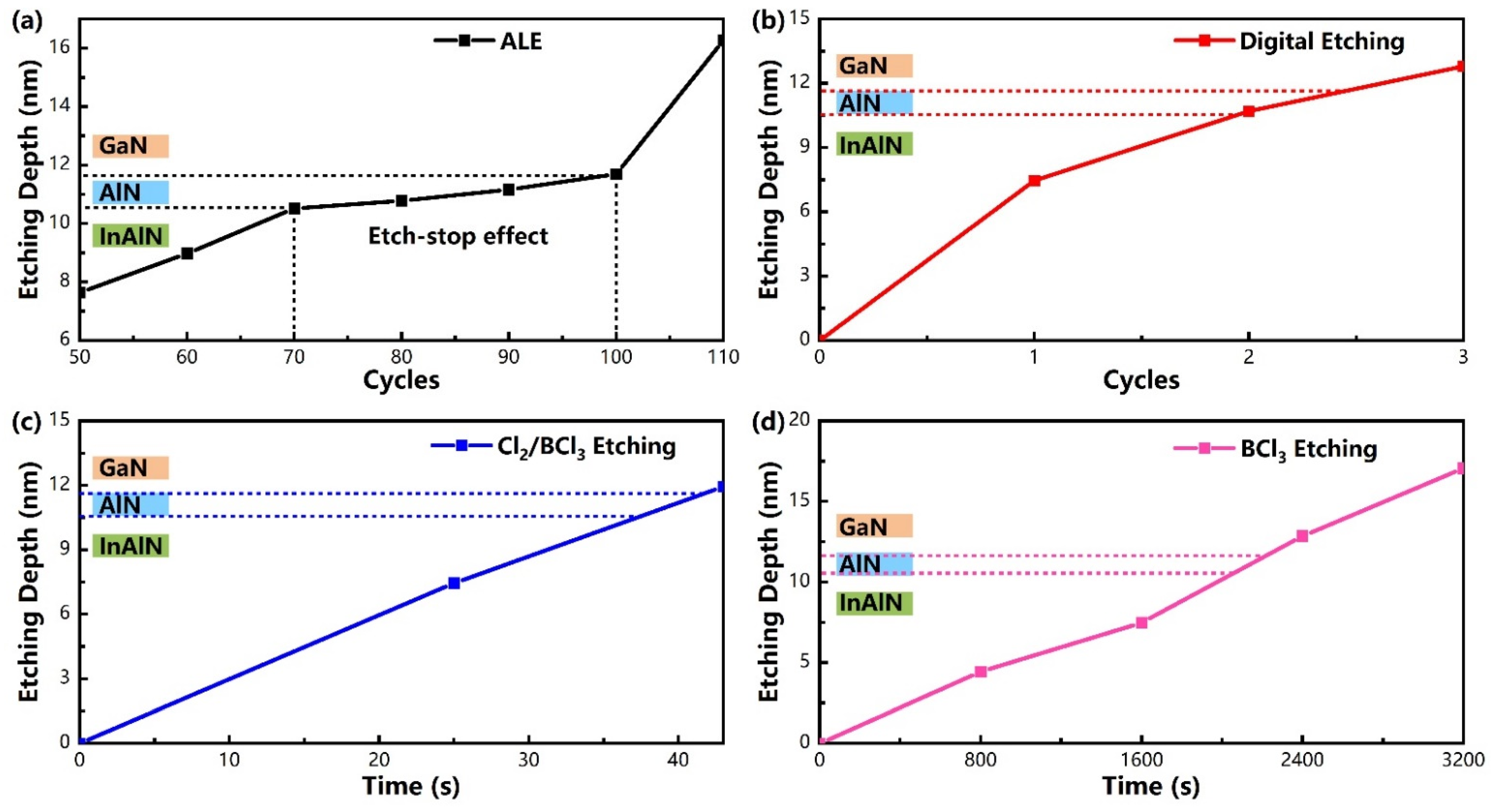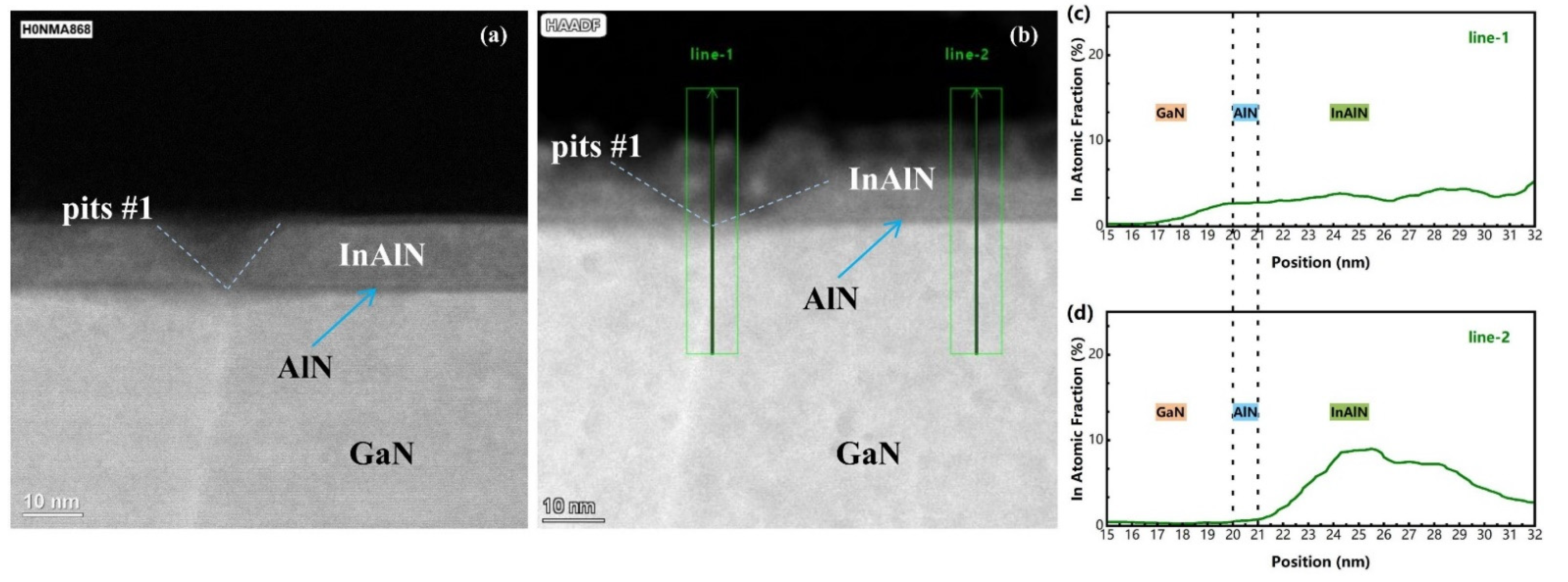The Atomic Layer Etching Technique with Surface Treatment Function for InAlN/GaN Heterostructure
Abstract
:1. Introduction
2. Experimental
3. Results and Discussion
4. Conclusions
Author Contributions
Funding
Institutional Review Board Statement
Informed Consent Statement
Data Availability Statement
Acknowledgments
Conflicts of Interest
References
- Huang, Y.-P.; Hsu, W.-C.; Liu, H.-Y.; Lee, C.-S. Enhancement-Mode Tri-Gate Nanowire InAlN/GaN MOSHEMT for Power Applications. IEEE Electron Device Lett. 2019, 40, 929–932. [Google Scholar] [CrossRef]
- Ma, C.; Gu, G.; Lü, Y. A high performance InAlN/GaN HEMT with low Ron and gate leakage. J. Semicond. 2016, 37, 024099. [Google Scholar] [CrossRef]
- Chiu, H.-C.; Wu, C.-H.; Chi, J.-F.; Chyi, J.I.; Lee, G.Y. N2O treatment enhancement-mode InAlN/GaN HEMTs with HfZrO2 High-k insulator. Microelectron. Reliab. 2015, 55, 48–51. [Google Scholar] [CrossRef]
- Wang, R.; Saunier, P.; Xing, X.; Lian, C.; Gao, X.; Guo, S.; Snider, G.; Fay, P.; Jena, D.; Xing, H. Gate-Recessed Enhancement-Mode InAlN/AlN/GaN HEMTs With 1.9-A/mm Drain Current Density and 800-mS/mm Transconductance. IEEE Electron Device Lett. 2010, 31, 1383–1385. [Google Scholar] [CrossRef]
- Chung, J.W.; Saadat, O.I.; Tirado, J.M.; Xiang, G.; Guo, S.; Palacios, T. Gate-Recessed InAlN/GaN HEMTs on SiC Substrate With Al2O3 Passivation. IEEE Electron Device Lett. 2009, 30, 904–906. [Google Scholar] [CrossRef]
- Gu, G.; Cai, Y.; Feng, Z.; Liu, B.; Zeng, C.; Yu, G.; Dong, Z.; Zhang, B. Enhancement-mode InAlN/GaN MISHEMT with low gate leakage current. J. Semicond. 2012, 33, 064044. [Google Scholar] [CrossRef]
- Hu, Q.; Li, S.; Li, T.; Wang, X.; Li, X.; Wu, Y. Channel Engineering of Normally-OFF AlGaN/GaN MOS-HEMTs by Atomic Layer Etching and High-k Dielectric. IEEE Electron Device Lett. 2018, 39, 1377–1380. [Google Scholar] [CrossRef]
- Hwang, I.-H.; Cha, H.-Y.; Seo, K.-S. Low-Damage and Self-Limiting (Al)GaN Etching Process through Atomic Layer Etching Using O2 and BCl3 Plasma. Coatings 2021, 11, 268. [Google Scholar] [CrossRef]
- Tang, J.; Hu, Y.; Zhang, Y.; Gu, Z.; Che, D.; Hu, D.; Chen, L.; Xu, K.; Zhuang, S. XPS Analysis of Gallium Nitride Film After O2/BCl3 Digital Etch. In Proceedings of the China Semiconductor Technology International Conference (CSTIC), Shanghai, China, 26 June–17 July 2020. [Google Scholar]
- Mikhailovich, S.V.; Pavlov, A.Y.; Tomosh, K.N.; Fedorov, Y.V. Low-Energy Defectless Dry Etching of the AlGaN/AlN/GaN HEMT Barrier Layer. Tech. Phys. Lett. 2018, 44, 435–437. [Google Scholar] [CrossRef]
- Kai, Z.; Zhou, J.; Cen, K.; Kong, Y.; Chen, T. Enhancement-mode Al2O3/InAlGaN/GaN MOS-HEMTs with a record drain current density of 1.7 A/mm and a threshold voltage of +1.5 V. In Proceedings of the China International Forum on Solid State Lighting: International Forum on Wide Bandgap Semiconductors China (SSLChina: IFWS), Beijing, China, 15–17 November 2016. [Google Scholar]
- Kanarik, K.J.; Lill, T.; Hudson, E.A.; Sriraman, S.; Tan, S.; Marks, J.; Vahedi, V.; Gottscho, R.A. Overview of atomic layer etching in the semiconductor industry. J. Vac. Sci. Technol. A Vac. Surf. Film. 2015, 33, 020802. [Google Scholar] [CrossRef] [Green Version]
- Burnham, S.D.; Boutros, K.; Hashimoto, P.; Butler, C.; Wong, D.W.S.; Hu, M.; Micovic, M. Gate-recessed normally-off GaN-on-Si HEMT using a new O2-BCl3 digital etching technique. Phys. Status Solidi (C) 2010, 7, 2010–2012. [Google Scholar] [CrossRef]
- Wu, J.; Lei, S.; Cheng, W.C.; Sokolovskij, R.; Wang, Q.; Xia, G.; Yu, H. Oxygen-based digital etching of AlGaN/GaN structures with AlN as etch-stop layers. J. Vac. Sci. Technol. A Vac. Surf. Films 2019, 37, 060401. [Google Scholar] [CrossRef] [Green Version]
- Huang, Y.-P.; Lee, C.-S.; Hsu, W.-C. Enhancement-Mode InAlN/GaN Power MOSHEMT on Silicon With Schottky Tri-Drain Extension. IEEE Electron Device Lett. 2020, 41, 1048–1051. [Google Scholar] [CrossRef]
- Freedsman, J.J.; Watanabe, A.; Ito, T.; Egawa, T. Recessed gate normally-OFF Al2O3/InAlN/GaN MOS-HEMT on silicon. Appl. Phys. Express 2014, 7, 104101. [Google Scholar] [CrossRef]
- Du, F.; Jiang, Y.; Qiao, Z.; Wu, Z.; Tang, C.; He, J.; Zhou, G.; Cheng, W.-C.; Tang, X.; Wang, Q.; et al. Atomic layer etching technique for InAlN/GaN heterostructure with AlN etch-stop layer. Mater. Sci. Semicond. Process. 2022, 143, 106544. [Google Scholar] [CrossRef]
- Wang, R.; Li, G.; Laboutin, O.; Cao, Y.; Johnson, W.; Snider, G.; Fay, P.; Jena, D.; Xing, H. 210-GHz InAlN/GaN HEMTs With Dielectric-Free Passivation. IEEE Electron Device Lett. 2011, 32, 892–894. [Google Scholar] [CrossRef]
- Lee, D.S.; Chung, J.W.; Wang, H.; Gao, X.; Guo, S.; Fay, P.; Palacios, T. 245-GHz InAlN/GaN HEMTs With Oxygen Plasma Treatment. IEEE Electron Device Lett. 2011, 32, 755–757. [Google Scholar] [CrossRef]
- Lee, D.S.; Gao, X.; Guo, S.; Palacios, T. InAlN/GaN HEMTs With AlGaN Back Barriers. IEEE Electron Device Lett. 2011, 32, 617–619. [Google Scholar] [CrossRef]
- Cui, P.; Zeng, Y. Technology of sub-100 nm InAlN/GaN HEMTs on silicon with suppressed leakage current. Solid-State Electron. 2021, 185, 108137. [Google Scholar] [CrossRef]
- Yang, L.; Zhang, B.; Li, Y.; Chen, D. Improved Schottky barrier characteristics for AlInN/GaN diodes by oxygen plasma treatment. Mater. Sci. Semicond. Process. 2018, 74, 42–45. [Google Scholar] [CrossRef]
- Turuvekere, S.; Karumuri, N.; Rahman, A.A.; Bhattacharya, A.; DasGupta, A.; DasGupta, N. Gate Leakage Mechanisms in AlGaN/GaN and AlInN/GaN HEMTs: Comparison and Modeling. IEEE Trans. Electron Devices 2013, 60, 3157–3165. [Google Scholar] [CrossRef]
- Zhao, S.L.; Hou, B.; Chen, W.W.; Mi, M.H.; Zheng, J.X.; Zhang, J.C.; Ma, X.H.; Hao, Y. Analysis of the Breakdown Characterization Method in GaN-Based HEMTs. IEEE Trans. Power Electron. 2016, 31, 1517–1527. [Google Scholar] [CrossRef]
- Buttari, D.; Chini, A.; Palacios, T.; Coffie, R.; Shen, L.; Xing, H.; Heikman, S.; Mccarthy, L.; Chakraborty, A.; Keller, S. Origin of etch delay time in Cl2 dry etching of AlGaN/GaN structures. Appl. Phys. Lett. 2003, 83, 4779–4781. [Google Scholar] [CrossRef]
- Chen, Z.; Fujita, K.; Ichikawa, J.; Egawa, T. Threading dislocation-governed degradation in crystal quality of heteroepitaxial materials: The case of InAlN nearly lattice-matched to GaN. J. Appl. Phys. 2012, 111, 053535. [Google Scholar] [CrossRef]
- Hiroki, M.; Maeda, N.; Kobayashi, T. Electrical properties and device characteristics of InAlN/AlGaN/ AlN/GaN heterostructure field effect transistors. Phys. Status Solidi 2010, 6, S1056–S1060. [Google Scholar] [CrossRef]
- Minj, A.; Cavalcoli, D.; Cavallini, A. Indium segregation in AlInN/AlN/GaN heterostructures. Appl. Phys. Lett. 2010, 97, 132114. [Google Scholar] [CrossRef]
- Kehagias, T.; Dimitrakopulos, G.P.; Kioseoglou, J.; Kirmse, H.; Giesen, C.; Heuken, M.; Georgakilas, A.; Neumann, W.; Karakostas, T.; Komninou, P. Indium migration paths in V-defects of InAlN grown by metal-organic vapor phase epitaxy. Appl. Phys. Lett. 2009, 95, 071905. [Google Scholar] [CrossRef]
- Onojima, N.; Higashiwaki, M.; Suda, J.; Kimoto, T.; Mimura, T.; Matsui, T. Reduction in potential barrier height of AlGaN/GaN heterostructures by SiN passivation. J. Appl. Phys. 2007, 101, 1214. [Google Scholar] [CrossRef]
- Hashizume, T.; Ootomo, S.; Oyama, S.; Konishi, M.; Hasegawa, H. Chemistry and electrical properties of surfaces of GaN and GaN/AlGaN heterostructures. J. Vac. Sci. Technol. B Microelectron. Nanometer Struct. 2001, 19, 1675–1681. [Google Scholar] [CrossRef] [Green Version]








| Etching Method | InAlN Etching Rate | AlN Etching Rate | GaN Etching Rate |
|---|---|---|---|
| Sample S1 | 0.15 nm/cycle (EPC) | 0.03 nm/cycle (EPC) | 0.46 nm/cycle (EPC) |
| Sample S2 | 7.46 nm/cycle (EPC) | -1 | -1 |
| Sample S3 | 17.88 nm/min | -1 | -1 |
| Sample S4 | 0.28 nm/min | -1 | 0.32 nm/min |
| Etching Method | RMS Roughness (nm) | Mean Roughness (nm) |
|---|---|---|
| Sample S0 | 0.71 | 0.47 |
| Sample S1 | 0.61 | 0.44 |
| Sample S2 | 0.69 | 0.47 |
| Sample S3 | 0.91 | 0.75 |
| Sample S4 | 0.89 | 0.66 |
| Sample S1_AlN | 0.60 | 0.45 |
| Surface Treatment Method | RMS Roughness (nm) | Rsh (Ω/sq) | 2-DEG Mobility (cm2·V−1·s) | 2-DEG Density (×1013 cm−2) |
|---|---|---|---|---|
| Sample S0 | 0.44 | 386 | 1210 | 1.33 |
| 1 cycle sample S1 | 0.56 | 454 | 954 | 1.44 |
| 2 cycles sample S1 | 0.47 | 440 | 1000 | 1.41 |
| 3 cycles sample S1 | 0.45 | 401 | 1030 | 1.51 |
| 4 cycles sample S1 | 0.39 | 360 | 1150 | 1.50 |
| 5 cycles sample S1 | 0.40 | 363 | 1120 | 1.53 |
Publisher’s Note: MDPI stays neutral with regard to jurisdictional claims in published maps and institutional affiliations. |
© 2022 by the authors. Licensee MDPI, Basel, Switzerland. This article is an open access article distributed under the terms and conditions of the Creative Commons Attribution (CC BY) license (https://creativecommons.org/licenses/by/4.0/).
Share and Cite
Du, F.; Jiang, Y.; Wu, Z.; Lu, H.; He, J.; Tang, C.; Hu, Q.; Wen, K.; Tang, X.; Hong, H.; et al. The Atomic Layer Etching Technique with Surface Treatment Function for InAlN/GaN Heterostructure. Crystals 2022, 12, 722. https://doi.org/10.3390/cryst12050722
Du F, Jiang Y, Wu Z, Lu H, He J, Tang C, Hu Q, Wen K, Tang X, Hong H, et al. The Atomic Layer Etching Technique with Surface Treatment Function for InAlN/GaN Heterostructure. Crystals. 2022; 12(5):722. https://doi.org/10.3390/cryst12050722
Chicago/Turabian StyleDu, Fangzhou, Yang Jiang, Zhanxia Wu, Honghao Lu, Jiaqi He, Chuying Tang, Qiaoyu Hu, Kangyao Wen, Xinyi Tang, Haimin Hong, and et al. 2022. "The Atomic Layer Etching Technique with Surface Treatment Function for InAlN/GaN Heterostructure" Crystals 12, no. 5: 722. https://doi.org/10.3390/cryst12050722
APA StyleDu, F., Jiang, Y., Wu, Z., Lu, H., He, J., Tang, C., Hu, Q., Wen, K., Tang, X., Hong, H., Yu, H., & Wang, Q. (2022). The Atomic Layer Etching Technique with Surface Treatment Function for InAlN/GaN Heterostructure. Crystals, 12(5), 722. https://doi.org/10.3390/cryst12050722








